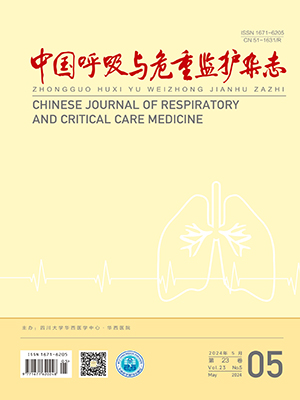Objective To study the sedative effects and safety of dexmedetomidine and midazolam
for acute exacerbate of chronic obstructive pulmonary disease ( AECOPD) underwentmechanical ventilation.
Methods 68 AECOPD patients underwentmechanical ventilation were enrolled and randomly divided into a
dexmedetomidine group ( n =34) and a midazolam group ( n = 34) by acute physiology and chronic health
evaluation Ⅱ ( APACHEⅡ) score. The patients in the dexmedetomidine group were given a loading dose
( 1 μg/kg) and then maintained with 0. 2-0. 8 mg·kg- 1 ·h- 1 . The patients in the midazolam group were
given a loading dose ( 0. 05 mg/kg) and then maintained with 0. 06-0. 2 mg· kg- 1 · h- 1 . Sedation level
was assessed by Ramsay score and maintained a Ramsay score of 3-4. The sedation onset time, disable
sedatives wake time, duration of mechanical ventilation, extubation success rate, ICU length of stay, and 28
days mortality after admission to the ICU were compared between two groups. And calmer respiratory
depression, circulatory and delirium adverse reactions incidence were also compared. Results The
differences in patients’age, gender, and APACHEⅡ score between two groups were not significant ( P gt;
0. 05) . Compared with the midazolam group, the dexmedetomidine group had more rapid onset of sedation
[ ( 49. 80 ±8. 20) s vs. ( 107. 55 ±19. 65) s, P lt;0. 01] , shorter wake-up time [ ( 18. 90 ±2. 30) min vs. ( 40. 82 ±19. 85) min, P lt;0. 01] , shorter duration of mechanical ventilation [ ( 4. 9 ±1. 6) d vs. ( 7. 8 ±2. 5) d,
P lt;0. 01] , higher successful extubation rate ( 79. 41% vs. 58. 82% , P lt;0. 01) , and shorter ICUlength of stay
[ ( 6. 5 ±2. 5) d vs. ( 9. 6 ±3. 4) d, P lt;0. 05] . Dexmedetomidine had lower respiratory depression rate, little
effects on hemodynamics, lower occurrence and short duration of delirium. Conclusion It is highly
recommended that dexmedetomidine be used for sedation in AECOPD patients with mechanical ventilation.
Citation: YANG Shukun,XIE Jangxia,HUO Kaixiu,XU Fuqin,CHEN Lanchun.. Dexmedetomidine versus Midazolam for Sedation of Acute Exacerbation of Chronic Obstructive Pulmonary Disease UnderwentMechanical Ventilation. Chinese Journal of Respiratory and Critical Care Medicine, 2013, 12(5): 481-484. doi: Copy




